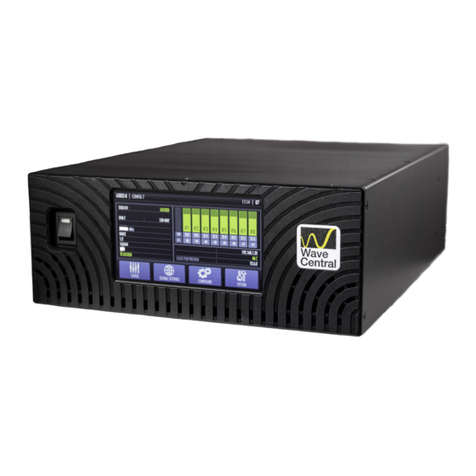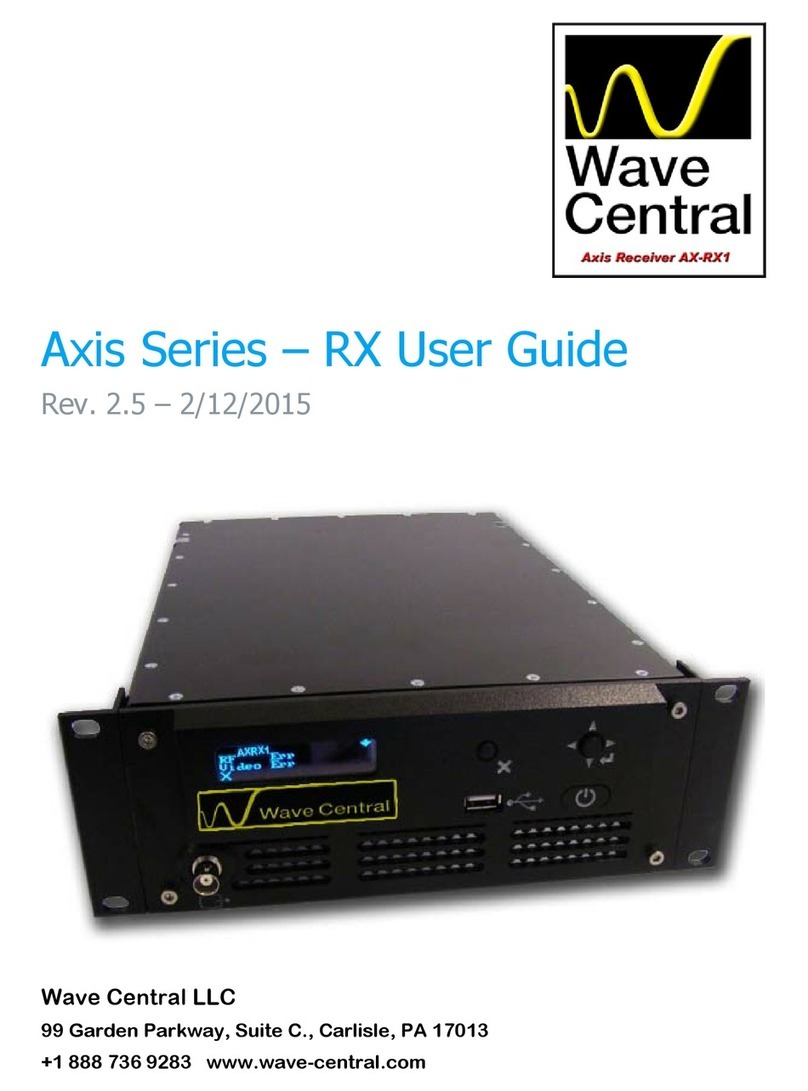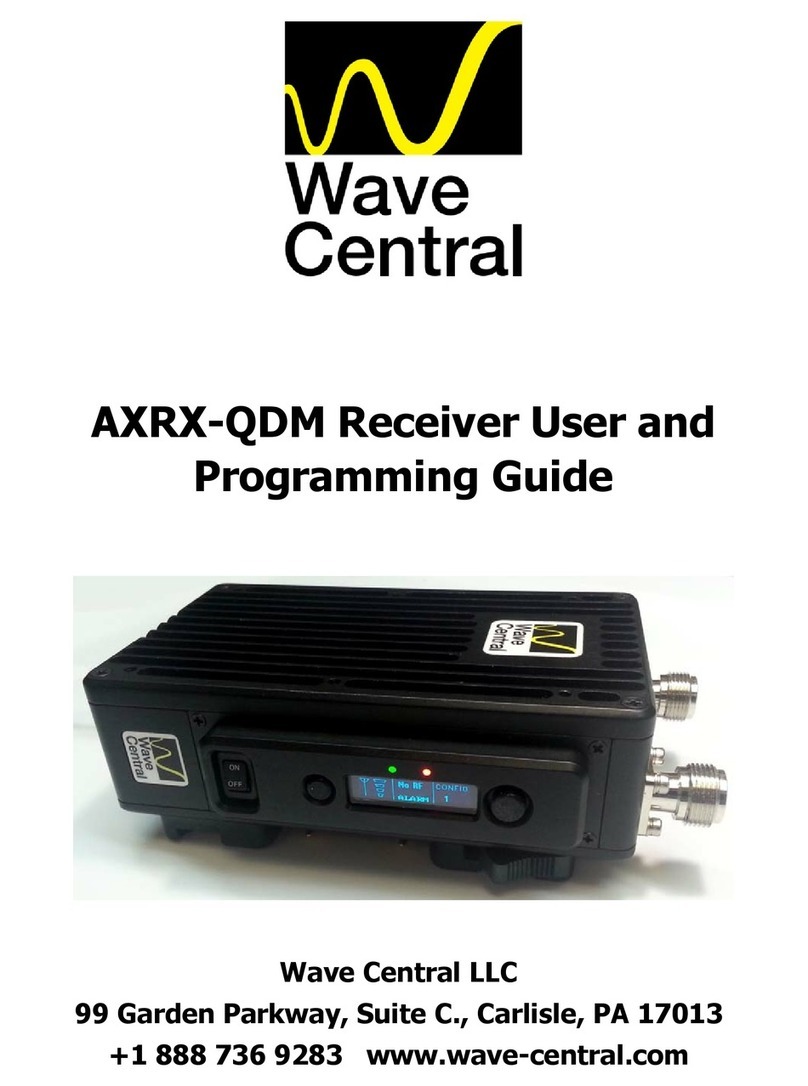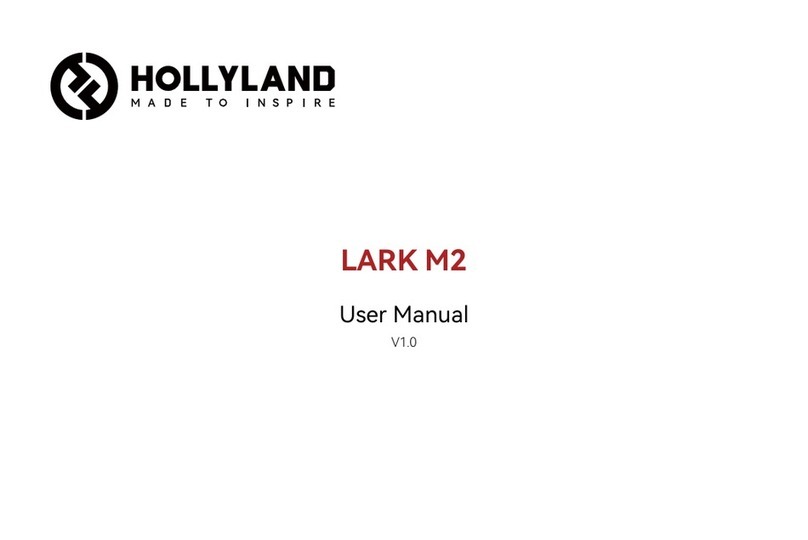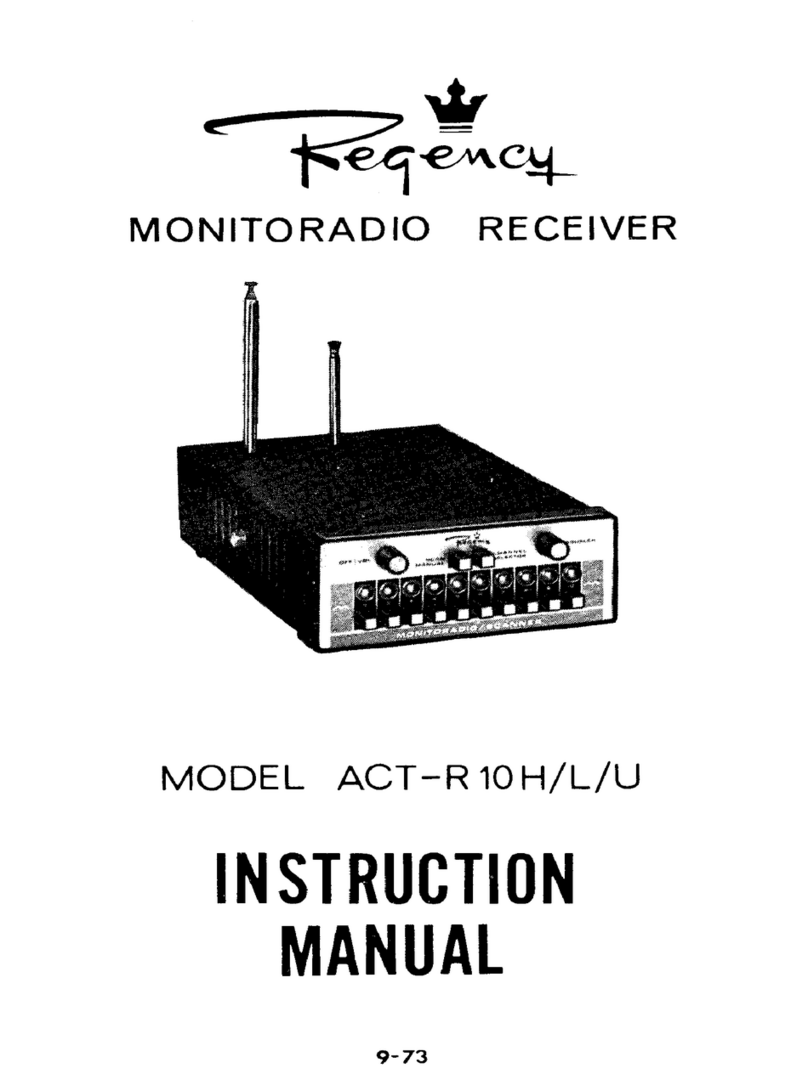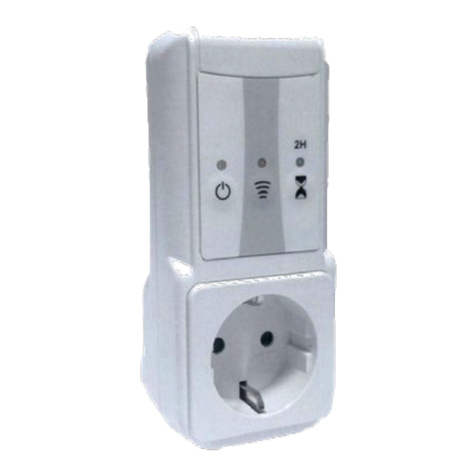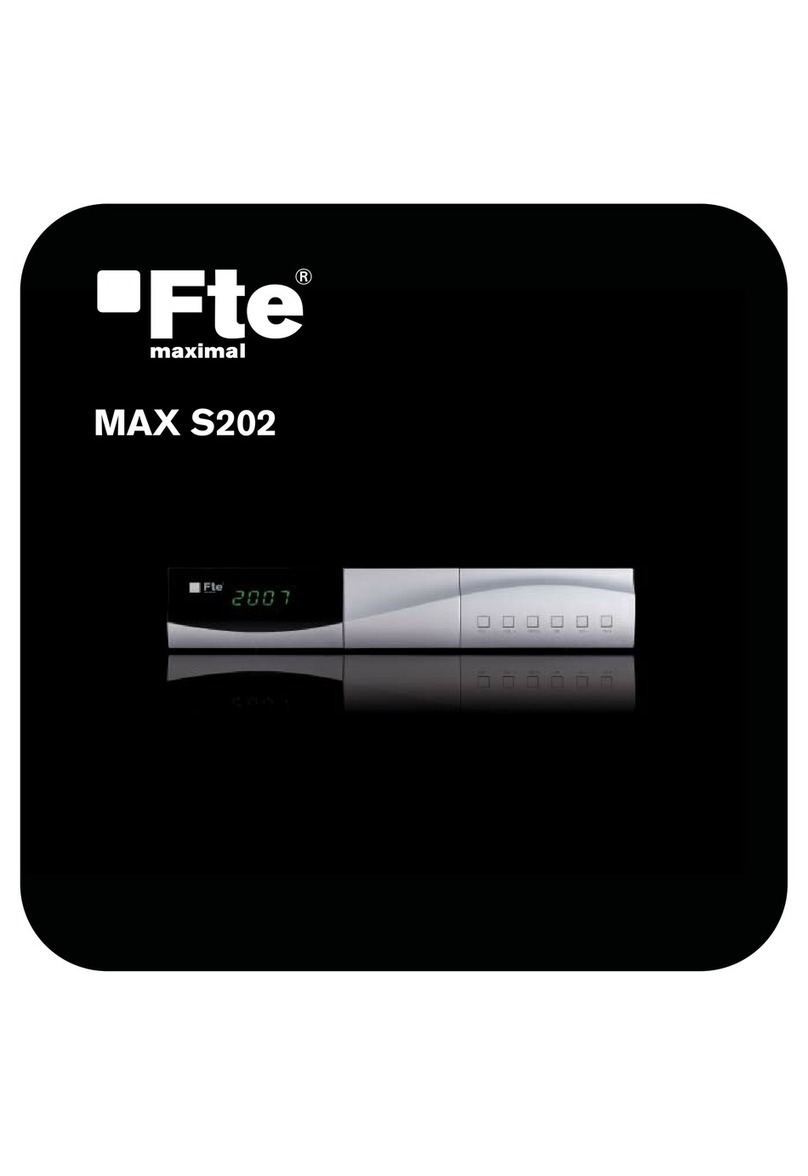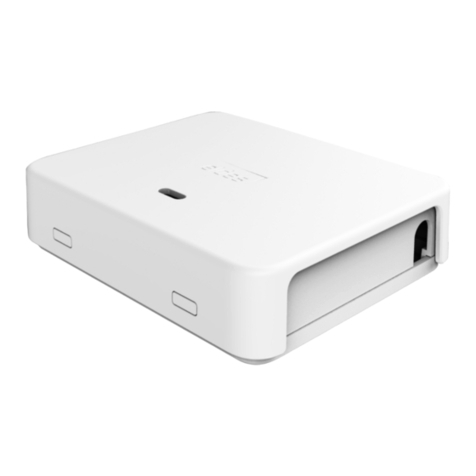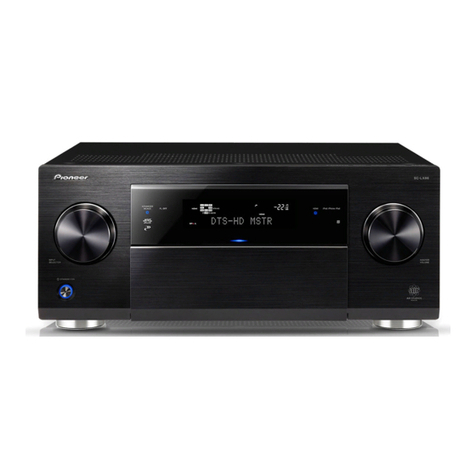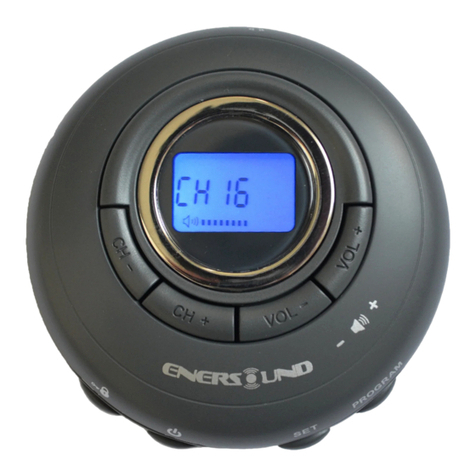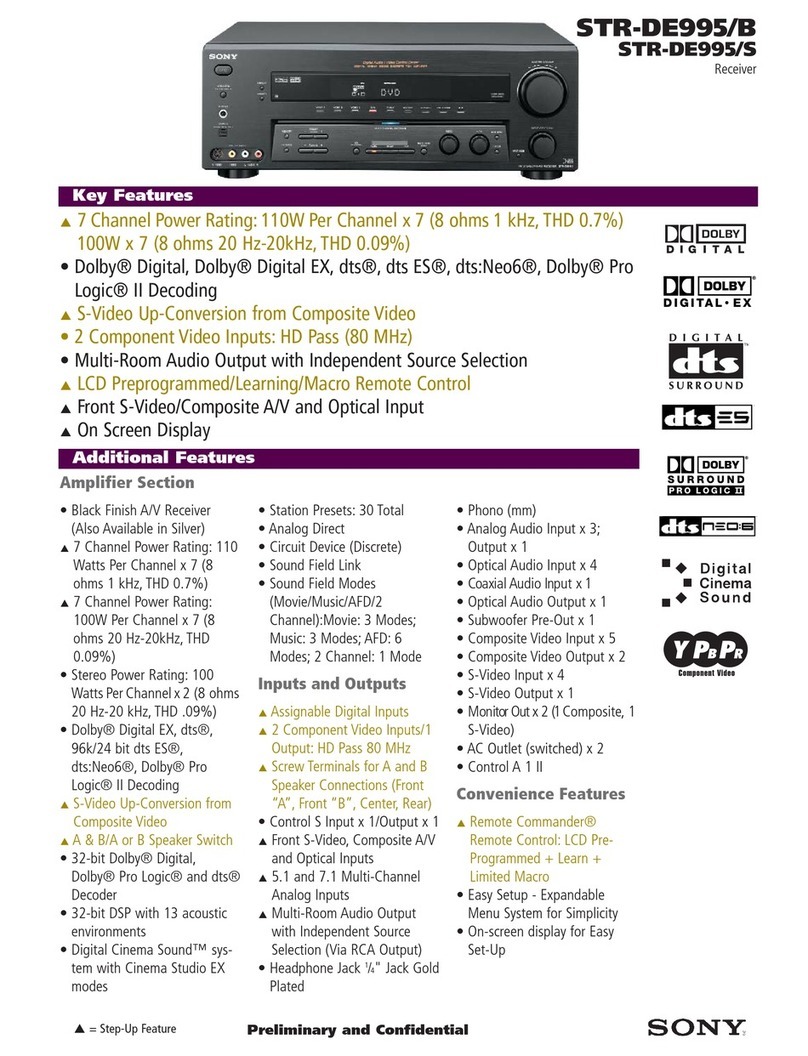Wave Central AXRX-QDM Operating instructions

Rev 2
January 2020
AXRX-QDM Receiver User and
Programming Guide
Wave Central LLC
99 Garden Park ay, Suite C., Carlisle, PA 17013
+1 888 736 9283 . avecentralrf.com

Rev 2
January 2020
WARNING
The HD/SDI Video input
connector is 75 Ohms. Make
sure that the video cable(s) are
fitted ith 75 Ohm connectors.
The illustration on the right is
the correct BNC connector.
Failure to do so ill damage the
BNC connector on the Pico and
Pico Plus transmitters. The
customer is liable for any
damages for not adhering to this
practice.

1.
Systems Description
This User Guide is about:
Equipment Title Operational Frequencies
AXRX-QDM Div ersity Receiv er 2GHz to 5. GHz
Compact Sector Antennas 2GHz to 5. GHz
Figure 1-1 – AXRX-QDM Receiver
1.1
What is the AXRX-QDM Receiver?
The AXRX-QDM Receiv er from Wav e Central is a feature-rich COFDM digital video receiv er,
which can operate in a v ariety of transmission bandwidths enabling the user to trade off
image quality against range, to suit all ty pes of missions.
The AXRX-QDM Receiv er has Wave Central at its core and is ideal for establishing long
duration rugged wireless video links, in harsh ex ternal env ironments, like mobile and urban
env ironments. The AXRX-QDM receiver is available in a variety of frequency bands.
Control is achiev ed through a front panel interface or by connecting the unit to an IP
network using the Ethernet interface given. You can quickly configure the dev ice in the field
with laptop PC and configuration software.
The product can be used with an optional external chargeable battery pack; ID X or Anton
Bauer, providing between four and fiv e hours battery life. The unit can also run from an
external DC supply which is included.
The front panel allows the user to switch channels and do basic configuration without the
need for connection to a PC, making it ideal for portable or mobile situations.

What are the Key Features of the AXRX-QDM Receiver?
Small dimensions: 5.7 x 3.5 x 1.6 inches (without cables or battery )
Low power
Fully featured /7/6/MHz demodulation
Maximum ratio combining antenna diversity
IP video streaming (RTSP and UDP) *
Ethernet control
Front Panel control
Specifications:
RF input (2) 2GHz to 5.8GHz
DVB-T Bandwidth 6, 7 & MHz
DVB-T Guard Interv als 1/32, 1/16, 1/ and ¼
DVB-T FEC 1/2, 2/3, 3/4, 5/6 & 7/
DVB T Constellations QPSK, 16QAM & 64QAM
Sensitiv ity <95dB
Video Line Standard PAL/NTSC
Resolutions (HD) 1920X10 0i/59.94/50Hz
1920X10 0p 30/29.97/25/24/23.97
1920X10 0psf 30/29.97/25/24/23.97
12 0x720p 60/59.94/50Hz
(SD) 720X4 0i 59.94Hz
720X576i 50Hz
Video Out (2) SD/HD SDI Video (1) Composite – 75 Ohm BNC
Audio Out Analog (2) Stereo Line lev el via LEMO 5-pin OB, Headset Monitor
Embedded
Power – DC Input 9 to 16VDC
Power Consumption 20 Watts
Av ailable Battery Plates IDX or Anton Bauer

1.2
What are the Features and Benefits of AXRX-
QDM
Receivers?
It can be v ery useful to understand how the features of the unit y ield tangible benefits to
y ou. This table summarizes these features and, more importantly , the benefits.
1.2.1 Features and Benefits Table
Key Features
Key Benefits
Compliant DVB
-
T Demodulator and
proprietary narrowband.
Full Demodulation , 7, and 6 MHz
Correct multi
-
mode operation
-
Perfect
integration with your current equipment.
Line Lev el
Audio / Video Out, Headphone
output.
Easy to use
-
Operations staff can use known
standard equipment.
Digital C OFDM Modulation
Excellent performance
-
Resistant to multipath
interference, delivers high quality video and
audio, also when mobile or in built up areas like
urban environments.
Low Delay , high quality video encoding
in MPEG-2 and MPEG-4
High reliability - Use a radio system like it was
a line. You can select between MPEG 2 and 4
to suit your operation.
Low latency Enables real-time operations like remote
vehicle control or UAV operations.
Sixteen Presets Available Better use of assets and resources - You can
preset frequencies into sixteen presets.
Configure the full operation in the calm of the
headquarters then the operations staff only
have to quickly select the preset with one
button.
High reliability and availability Reduced maintenance requirement, reduced
spares holding, resulting in important cost
benefits across the life of the system.
Low Mass Applicable for discrete operation in the field.
Note: AXRX-QDM Receiv ers are frequency specified because they hav e internal down
converters.

1.3
Getting an Overvie of the AXRX-QDM Receiver
Diagram: AXRX-QDM Receiver Primary System
Figure 1-2 Primary System Layout
Primary Unit bottom panel shown
1
2
3
13
9
1
4
5
7
6
12
11
10
13

No
Item
Function
1 AXRX-QDM Receiver. Primary Unit bottom panel shown.
2
N Connector 2
-
way female for antenna
Antennas connect here. Do not
tighten too much – tighten with
y our hand.
3
N Connector 2
-
way female for antenna
Two antennas used for div ersity
reception.
4 USB Mini-B 5-way receptacle Connects to y our PC for
programming the AXRX-QDM
receiver.
5 RJ45 -way receptacle (sockets). Connects from y our PC.
6 LEMO OB 4-way receptacle (sockets) Power Input.
7 LEMO OB 6-way receptacle (sockets), For control/data in and out.
LEMO OB 5-way receptacle (sockets). Audio output.
9 1/
”
Stereo Phone Jack Headset audio monitoring
10 BNC - 75 Ohms chassis mount SD/HD SDI
11 BNC - 75 Ohms chassis mount SD/HD SDI
12 BNC - 75 Ohms chassis mount For analo g video output.
13 Battery Adapter Plate IDX or Anton Bauer
Table 1-3 – Primary System Diagram Key

2.
Getting Started
2.1
Identifying your Device
The AXRX-QDM Receiver is described in this User Guide.
Figure 2-1 – AXRX-QDM Receiver sho ing Control Panel
This is a AXRX-QDM Receiv er [Quick Deploy Mini]
Its type designation is: AXRX-QDM
Dimensions: 5.7” (L) x 3.5” (W) x 1.6” (D)
Less cables and battery adapter plate
Weight: 1.4 pounds
Operating Temperature: -10 degrees C to +45 degrees C
Power Consumption: W. DC Input 6 to 16VDC
2.2
About the Labels on your AXRX-QDM Receiver
Which model do I have? What is its Serial Number?
This topic contains information covering placards, labels, markings, etc., showing the part
number, legend and location of each placard, label, or marking required for safety or
maintenance important information.

Step 1: Identify the Device Label
Figure 2-2 – AXRX-QDM Receiver Label
No
Item
1 AXRXP-2G family of products.
2 Frequency range, 2GHz in this example.
3 WC with four digit serial number. This number will be necessary during a
support call.
Table 2-3 – AXRX-QDM Receiver Label Key
2.3
Planning the Hard are Installation
During the layout of the system, you must give careful consideration of the location of this
and all other related modules. Some of the items to think about include:
Space - Keep 100mm clearance left and right for cable bending.
How near to other devices (for example, source equipment).
Length of cables.
Environmental conditions (temperature, humidity, etc.)
Access for repair.
2.4
About the Soft are ith your AXRX-QDM Receiver
The AXRX-QDM Receiver has
t o
software elements:
Firm are
that operates on the primary board of the device.
Control Application
that you operate on your Windows PC.

About the Firmware
Altho ugh much of the unit is built up of hardware components, many of the sophisticated
features are done in the firmware operating on a Field Programmable Gate Array (FPGA) in
the dev ice.
When you must do an internal software upgrade we can give you an installer which contains
all the code to do this easily .
About the Control Application
The software tools giv e users with a convenient access to the most usual features and
functions of the Device. All software tools are implemented as a web interface. The
advantage of a web interface is that it is independent from the user’s operating system and
it is not necessary to hav e special software on the host PC.
The computer display control application of the unit gives access to many of the features of
the radio but for more sophisticated operations and configuratio n tasks you’ll connect up a
PC operating a web browser to access the Control Pages on your AXRX-QDM Receiver.
The Control Page enables y ou to set up sixteen presets in the radio and hav e control of
many parameters of the unit.
Here’s what the receiv er’s Control Pages look like:
Screenshot: AXRX-QDM Receiver Control Pages
Figure 2-4 – AXRX-QDM Receiver Control Pages

3.
Controls, Connections and Indicators
3.1
About Controls, Connections and Indicators
You must find all the controls and connections on the unit. You also must identify and
interpret alarms or indicators. These topics will help you identify all these features.
The dev ice has front and rear panels which contain all the interface connections for the
units and the controls and indicators.
The front panel contains the control functions used for in-field configuration and all
connections are installed on the rear panel.
3.2
Exploring the Front Panel
Diagram: Front Panel
Figure 3-1 AXRX-QDM Receiver Front Panel
No Item Used for...
1 Power Switch Power the receiver
2 Cancel Button Each time you push the Cancel button the Field
Controller steps up one menu lev el.
3 Nav igation
Button.
Push the Nav igation button in to select menus or
options.
Move the Navigation button up and down to move
between menus or change options.
Move the Navigation button left and right to select
numbers/letters when editing values.
4 Two line OLED
display .
User interface.
Table 3-2 – AXRX-QDM Receiver Front Panel Key
2
4
3
1

3.3
Exploring the Control Panel
The control panel is presented as a Field Controller and is on the front panel of the AXRX-
QDM receiver.
3.3.1
Field Controller Operation
The unit has a simple to use two button co ntrol sy stem which has been designed for use in
the field where it can be necessary to make adjustments to the AXRX-QDM Receiver settings
quickly and easily. An in-depth description on how to operate the Field Controller and
nav igate through the units settings is giv en later in this guide.
3.3.2
Alarm System
The Field Controller can be setup to show a flashing Lo Battery alarm when the v oltage
reaches a user-specified minimum level. There are no other visual or audible alarms on the
AXRX-QDM Receiv er.

4.
Setting up your AXRX-QDM Receiver
4.1 Connecting the Antennas
This topic describes connecting systems designed mainly for sending the RF signals. Of all
the variables affecting single-channel radio communications, the one item which an operator
has the most control is the antenna. With the right antenna, an operator can change a
marginal net into a reliable net.
There are two antenna interfaces on the rear panel of the AXRX-QDM receiv er. Antenna one
and two must be attached for optimum operation.
CAUTION: Antennas must be connected directly to the unit. If you have to use cables
between the antennas and the receiver (in a mobile situation for example), keep them short
and use very high quality cable.
Before you Start
This is necessary:
Two Compact Sector antennas that align with the frequency range of your AXRX-QDM
receiver.
Step 1: Attach the Antennas
1.
Connect the antennas to the N connector receptacles on the top panel of the AXRX-QDM
receiver.
2.
Do not tighten the antennas too much – tighten with y our hand.
Step 2: Set Antenna Polarization
1.
COFDM links are very robust and are tolerant to changes in antenna location, but, it is
important to try and keep the antennas in the same plane if possible.
2.
The antennas used with the COFD M links are usually vertically polarized.
3.
The Compactor antennas beam width azimuth of 110 degrees and a elevation beam width
of 1 degrees, as exampled for 2 GHz operation.
4.
Rotation of the antennas should be directed toward the transmitter.
Next Steps
Connect the DC Power.

4.1
Connecting the DC Po er
The AXRX-QDM receiver requires 12VDC. This can be supplied from a vehicle, an AC Adaptor
or a battery pack.
Before you Start
This is necessary:
A 12VDC Power Source
A AXRX-QDM receiv er
Step 1: Connect the DC Power
1.
Connect a fully charged battery IDX or Anton Bauer to the battery adapter plate
Next Steps
Connect Video and Audio Signals.
4.2
Connecting AC Po er
Before you Start
This is necessary:
A 12V AC Adapter
AXRX-QDM receiv er.
Step 1: Connect the AC Power
1.
Connect the LEMO OB 4- ay plug (pins) from the AC adaptor to the LEMO OB 4- ay
receptacle (sockets) on the AXRX-QDM receiv er which is on the bottom panel.
2.
Connect AC mains plug to your local AC supply and switch on.
Next Steps
Connect Video Signals.
4.3
Connecting Video Signals
There are three video outputs on this unit:
Composite Video (monitoring) – BNC 75 Ohms
SD/HD SDI – BNC 75 Ohms, output 1
SD/HD SDI – BNC 75 Ohms, output 2

4.4
Connecting Audio Signals
Before you Start
This is necessary:
AXRX-QDM receiv er.
LEMO 5-way plug harness with 2 female XLR connectors.
Two audio monitors.
Head phones to monitor audio at the receiver.
Step 1: Connect Audio Signal
1.
Connect the LEMO OB 5-way plug to the AV receptacle of the AXRX-QDM receiv er.
2.
Connect the XLR 3-way plugs to the audio mixer.
3.
Switch on and tune the receiv er to a transmission carrying audio.
4.
Your audio will be heard at the audio mixer.
5.
Connect headset into 1/ ” Stereo jack on the side of the receiver.
6.
Your audio will be heard on the headset.
4.5
Connecting Data Signals
Before you Start
This is necessary:
AXRX-QDM receiv er
Data Cable Assembly (optional)
A PC or other data monitoring dev ice.
Step 1: Connect Data Signal
1.
Connect the LEMO 6-way plug to the DATA receptacle of the AXRX-QDM receiv er.
2.
Connect the D-Type 9-way plug (sockets) marked DATA to your PC or other data
monitoring device.
3.
Switch on and tune the receiv er to a transmission carrying data.
4.
Your data will be received across the link.

4.6
Connecting Control Signals
The AXRX-QDM receiver’s internal settings for the receiv er and the Field Controller can be
controlled by ex ternal software when connected to a PC. This connection could be through
the IP network or a USB serial connection.
The Mission Controller software package is av ailable to support ex ternal control of the
AXRX-QDM receiver and the Field C ontroller, and give a full deployment management
tool.
Before you Start
This is necessary:
AXRX-QDM receiv er
Ethernet Cable Assembly (optional)
A PC with a web browser.
Step 1: Connect Data Signal
1.
Connect the RJ45 -way plug to the ETHERNET receptacle of the AXRX-QDM receiver.
2.
Connect the other RJ45 plug to the Ethernet receptacle on your PC.
4.7
About IP Control
The AXRX-QDM uses IP Control to share data with a Personal Computer for most
programming operations. This is the primary means of connecting to the device and giv es
access to settings and configurations quickly and easily.
The IP interface enables y ou to control the unit with a PC with a web browser and for
streaming video. The RJ45 connector on the rear of the unit marked Ethernet is compatible
with 10/100 Base-T Ethernet networks.
The unit passes IP signals through the IP interface on the bottom
panel. This is an RJ45 Jack.
4.8
About Mission Commander
Mission Commander is a software tool designed to configure and manage Wave Central
dev ices.
The AXRX-QDM Field C ontroller can be configured and upgraded by connecting to Mission
Commander through the USB port on the side panel.

5.
Basic Operation
5.1
Starting and Stopping the AXRX-QDM Receiver
AXRX-QDM receiver units don’t have power switches – y ou simply apply power to them and
they will start up.
Before you Start
This is necessary:
A AXRX-QDM receiv er
A source of power.
Step 1: Powering Up
1.
Power-on the AXRX-QDM receiver with one of the procedures in Setting up your
AXRX-QDM
Receiv er earlier.
2.
You’ll see an image on the Field Controller screen on the front panel.
Step 2: Stopping the System
It is important to stop the sy stem carefully. This makes sure that all processes are
terminated correctly and no data or settings become unav ailable.
1.
Make sure the unit is not updating software or apply ing configuration changes, and that
the unit is not in sleep mode.
2.
Disconnect the power cable from the AXRX-QDM receiver.
3.
On the front panel the Field C ontroller screen will go off. (Screen will stay on if
connected to PC with USB)
4.
The sy stem is stopped safely.
Next Steps
Exploring the Control Panel.
5.2
Working ith the Control Panel
The control panel is presented as a Field C ontroller and is on the front panel.
Before you Start
This is necessary:
A fully powered AXRX-QDM receiver.

Step 1: Interpret the Display
Figure 5-1 Working ith the Control Panel
No
Name
Notes
1 Up Arrow There are more options available in this menu.
Push the nav igation button Up to see more options.
2 Down Arrow There are more options available in this menu.
Push the nav igation button Do n to see more options.
3 Enter Arrow There are sub-lev el menus av ailable OR it is necessary to
make sure of a step, such as changing a setting.
Push the nav igation button to access the sub-level menu
or save the changes you have made to that setting.
4 Scroll Left and
Right
It is possible to scroll left and right.
Push the navigate button right to scroll right or left to
scroll left. This is usually for entering tex tual or numeric
information.
5 Exit Symbol It is possible to Exit the current part of the menu.
Push the cancel button to go up one level. Changes made
will not be saved.
Table 5-2 – Working ith the Control Panel Key

Step 2: Use the Field Controller Screen Lock
To lock the Field Controller, simply hold down the two buttons on the front panel for
approximately four seconds. A small key sy mbol will show in the bottom right corner of the
screen. To unlock the screen simply hold down the buttons again for four seconds.
5.3
Exploring the Control Panel Menu Structure
The Field Controller has three primary menus each of which have many sub-menus. By
nav igating through these menus, it is possible to see the status of the unit’s parameters and
change settings without the use of a PC. The three menus are:
Unit Status
Unit Control
Local Settings.
Before you Start
This is necessary:
A fully powered AXRX-QDM receiver.
Step 1: Explore the Unit Status Menu Structure
Top
Menu
Second
Level
Function
Default Value
Unit Status Freq Shows current receiv er frequency 2405.000MHz
SNR A Shows current SNR (Antenna A) N/A
SNR B Shows Current SNR (Antenna B) N/A
B/W Shows current bandwidth N/A
Pre Err Shows the bit error rate for pre-
errors.
N/A
Post Err Shows the bit error rate for post-
errors.
N/A
Pkt Err Shows the number of packet errors
coming out of the error correction
system.
N/A
Input level A Shows the level in dBm of the signal
being received on antenna A
N/A
Input level B Shows the level in dBm of the signal
being received on antenna B
N/A

IP Addr Shows current IP address of the unit 172.16.1.120
FPGA Temp Shows FPGA Temp (°c) N/A
S/W Ver. Shows current software issue number
of the receiver device (D350 PCB)
N/A
ESN Shows electronic serial number N/A
Table 5-2 – Working ith the Unit Status Menu
Step 2: Explore the Unit Control Menu Structure
Top
Menu
Second
Level
Third
Level
Function
Default
Value
Unit
Control
RF Freq Set Unit Frequency 2405.000MHz
Demod Set narrowband or DVB-T NB
NB Demod B/W Set Narrowband
bandwidth (2.5MHz,
1.25MHz, 625kHz)
2.5MHz
Guard Set Guard Rate (1/16,
1/ )
1/16
Spectrum Set spectrum type (Auto,
Normal or inverted)
Norm
DV B-T
Demod
B/W Set DVB-T bandwidth
( MHz, 7MHz, 6MHz)
MHz
Decoder Set decoder delay (Low
delay or Compliant)
Low Delay
Guard Set Guard Rate (Auto, ¼,
1/ , 1/16, 1/32)
Auto
Spectrum Set spectrum type (Auto,
Normal or inverted)
Auto
Decoder Service Set unit Identifier Solo-1
IP DHCP Set DHCP (On or Off) On
IP Addr Set IP address 172.16.1.120
Netmask Set IP Net Mask 255.255.255.0
Other manuals for AXRX-QDM
1
Table of contents
Other Wave Central Receiver manuals
Popular Receiver manuals by other brands
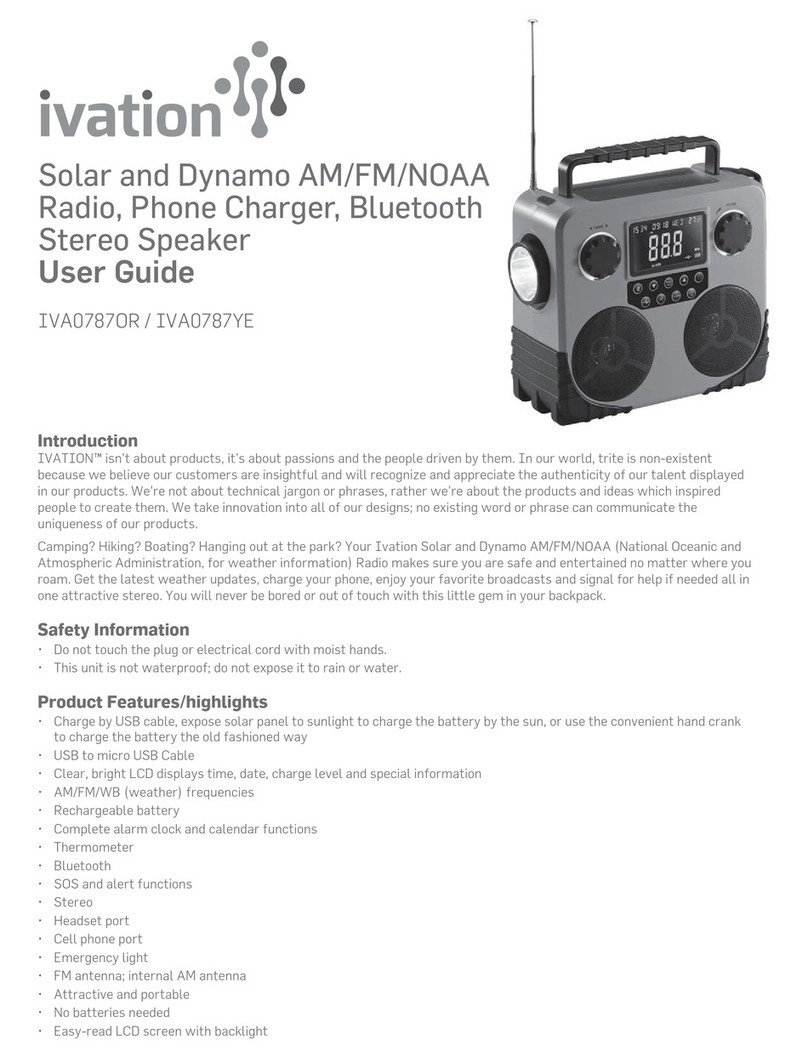
Ivation
Ivation IVA0787OR user guide

Panasonic
Panasonic SHFX71 - WIRELESS SYSTEM operating instructions

Overhead door
Overhead door CodeDodger Installation and programming instructions

Sony
Sony ICF-M35OV operating instructions
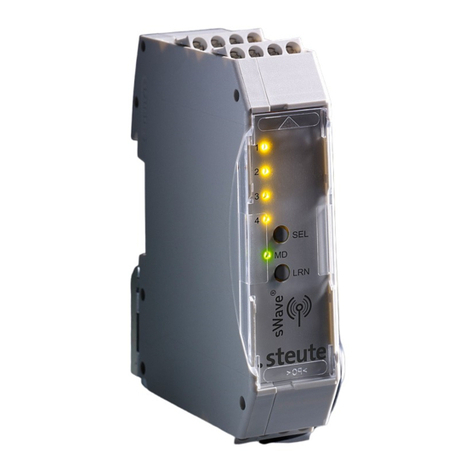
steute
steute RF Rx SW868-4S 48V Mounting and wiring instructions
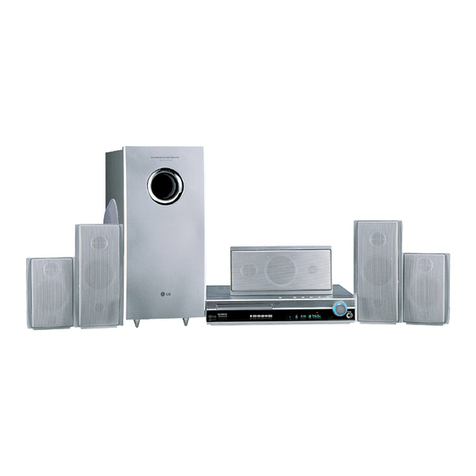
LG
LG LH-D6530A owner's manual
